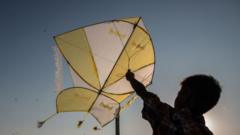With Jakarta losing significant green spaces, kite-flying remains a cherished pastime for many children. However, safety hazards near airports have led to crackdowns and conflicts over this cultural practice.**
Indonesian Youths Navigate Air Safety and Cultural Heritage Amidst Kite-Flying Craze**

Indonesian Youths Navigate Air Safety and Cultural Heritage Amidst Kite-Flying Craze**
Children in Indonesia find themselves torn between their love for kite-flying and the safety concerns of nearby airports, raising questions about urban space and cultural traditions.**
In a paddy field just two kilometers from Jakarta's bustling Soekarno-Hatta International Airport, the joyful sounds of children flying kites fill the air, juxtaposed against the roar of incoming planes. Amidst laughter and excitement, the persistent threat of airport authorities looms over them, creating a tension-filled environment for what is one of Indonesia's most beloved pastimes.
Seven-year-old Atif shares his enthusiasm while expressing a newfound courage in the face of authority. "Now I'm braver, so I go along with it when they scold me," he tells those gathered, showcasing a blend of childhood defiance and resilience. Kite-flying has indeed taken off as students enjoy their summer holidays, but authorities warn that the colorful kites pose significant risks to aircraft safety.
A recent report from air traffic controller AirNav Indonesia highlighted how kites disrupted 21 flights over a three-day period in July, leading to diversions and aborted landings. Airport head Putu Eka Cahyadi classified kites as “moving obstacles,” which can interfere with critical aircraft systems. The past few years have seen several safety incidents, including a 2024 helicopter crash in Bali attributed to kite strings.
In response to the ongoing threat kites pose, Indonesia's transport minister Dudy Purwagandhi has urged cooperation from airport authorities and local governments, emphasizing a need for education regarding the risks associated with kite-flying. In an effort to redirect children to safer pastimes, authorities have introduced other sports, yet kite-flying—rooted deeply in Indonesian culture—proves resilient against such initiatives.
Traditionally constructed from materials like leaves and colorful cloth, kites are used for various cultural practices, including rice harvest ceremonies and as offerings in Bali. Kite expert Asep Irawan notes the historical significance and cultural richness tied to this hobby, making it nearly impossible to eradicate despite growing safety concerns.
The complexity of urbanization has robbed Jakarta of 31% of its green space over the past two decades. Children such as Rasha, a 17-year-old kite maker, lament the lack of safe flying spaces nearby, stating, “There’s nowhere else around here.” As they navigate these restricted areas, children remain dedicated to their craft, engaging in occasional competitions despite the risk of having their kites confiscated or destroyed by officials.
Though regulations impose hefty fines for dangerous hobbies near airports, children still find themselves struggling to balance safety and enjoyment. The cultural significance of kite-flying intertwines with their urban experiences, and while authorities seek safety, the children echo a desire for understanding and space to fly freely. The delicate interplay of tradition and safety continues to unfold in the skies of Indonesia, revealing both the joy and the challenges of urban life.
Seven-year-old Atif shares his enthusiasm while expressing a newfound courage in the face of authority. "Now I'm braver, so I go along with it when they scold me," he tells those gathered, showcasing a blend of childhood defiance and resilience. Kite-flying has indeed taken off as students enjoy their summer holidays, but authorities warn that the colorful kites pose significant risks to aircraft safety.
A recent report from air traffic controller AirNav Indonesia highlighted how kites disrupted 21 flights over a three-day period in July, leading to diversions and aborted landings. Airport head Putu Eka Cahyadi classified kites as “moving obstacles,” which can interfere with critical aircraft systems. The past few years have seen several safety incidents, including a 2024 helicopter crash in Bali attributed to kite strings.
In response to the ongoing threat kites pose, Indonesia's transport minister Dudy Purwagandhi has urged cooperation from airport authorities and local governments, emphasizing a need for education regarding the risks associated with kite-flying. In an effort to redirect children to safer pastimes, authorities have introduced other sports, yet kite-flying—rooted deeply in Indonesian culture—proves resilient against such initiatives.
Traditionally constructed from materials like leaves and colorful cloth, kites are used for various cultural practices, including rice harvest ceremonies and as offerings in Bali. Kite expert Asep Irawan notes the historical significance and cultural richness tied to this hobby, making it nearly impossible to eradicate despite growing safety concerns.
The complexity of urbanization has robbed Jakarta of 31% of its green space over the past two decades. Children such as Rasha, a 17-year-old kite maker, lament the lack of safe flying spaces nearby, stating, “There’s nowhere else around here.” As they navigate these restricted areas, children remain dedicated to their craft, engaging in occasional competitions despite the risk of having their kites confiscated or destroyed by officials.
Though regulations impose hefty fines for dangerous hobbies near airports, children still find themselves struggling to balance safety and enjoyment. The cultural significance of kite-flying intertwines with their urban experiences, and while authorities seek safety, the children echo a desire for understanding and space to fly freely. The delicate interplay of tradition and safety continues to unfold in the skies of Indonesia, revealing both the joy and the challenges of urban life.
















